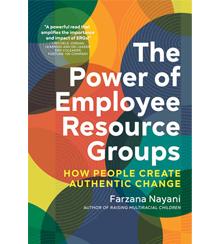Employee resource groups are more than “food, fun, and flags”
Diversity, equity, and inclusion consultant Farzana Nayani explains how to establish and nurture ERGs that deliver outsized benefits to companies and their stakeholders.

The Power of Employee Resource Groups: How People Create Authentic Change
by Farzana Nayani, Berrett-Koehler Publishers, 2022
In 1964, in the aftermath of race riots in Rochester, New York, Joseph Wilson, the CEO who transformed the Haloid Photographic Company into Xerox, invited Black employees to come together to address and remedy racial discrimination within the company. This group evolved into the National Black Employees Caucus, the first employee resource group (ERG). A half-century later, ERGs are a ubiquitous feature of the corporate landscape.
“ERGs have formed within the workplace to support and represent people with identities and demographics related to gender, race, sexual orientation, ability/disability, caregiver roles, military status, religious affiliation, generation, geographic area, job function, and more,” writes diversity, equity, and inclusion consultant and coach Farzana Nayani in The Power of Employee Resource Groups. In this handbook, Nayani offers practical advice to leaders of companies and ERGs who want to ensure that the time and resources they invest in their own groups are well spent.
“There is much debate as to whether affinity groups and ERGs are simply there to celebrate ‘food, fun, and flags,’” writes Nayani. But that’s a reductionist view, she says, one that ignores a host of potential benefits ERGs can provide to employees, companies, and communities. Nayani ticks them off: support, opportunities, and a voice for marginalized employees; enhanced leadership development and innovation pipelines; better employee engagement; increased reputational capital for the company; and more inclusive and socially responsible corporate behaviors that can deliver dividends to the communities in which businesses operate.
The key to achieving these benefits, says Nayani, is forging an explicit connection between a company’s ERGs and its organizational goals in five areas: workforce, workplace, marketplace, community, and suppliers. “Each of these five pillars is an area of focus where employee resource groups can offer contributions and also receive the benefits of efforts focused on the key themes,” she adds.
In the marketplace, for instance, ERGs can provide insights and feedback regarding the company’s customer offerings and marketing campaigns. They also can reach out to underserved or emerging customer segments, as when the Latinx ERG at a telecom company hosted an event introducing a local Latin American community to the company’s latest cellphone. “This increased brand affinity among the community, and sales of the device skyrocketed within this particular demographic,” reports Nayani.
The idea behind the pillars is not to exploit ERGs; it is meant to clarify, expand, and balance their benefits. “It would be tone-deaf to focus solely on business profitability at the expense of the workplace and workforce engagement, particularly if employee morale is challenged by events in society at large,” warns Nayani. “At the same time, employee resource groups cannot exclusively focus on social causes, as your ERGs are situated within companies that need to perform and deliver services. As a result, there needs to be a constant reevaluation and exploration of which of these pillars are the focus for each month and quarter….”
Nayani’s broader, more strategic approach can produce a more compelling business case for corporate investment in ERGs and greater support among senior leadership, especially when the results are quantified (metrics, always more metrics). But it also increases the performance pressure on ERGs and their leaders. This is no small consideration, because participation in ERGs is voluntary and almost always uncompensated, and employees must fit it into already demanding jobs.
“The way forward is through increased awareness about the contributions and impact of ERGs,” writes Nayani. She suggests that ERG members and their managers establish “reasonable expectations” for ERG participation and that participation be considered in performance reviews and promotion decisions.
The need to encourage and reward the efforts of ERG leaders is even more pressing. “In addition to doing extra work, and having the knowledge, passion, and commitment to contribute to the ERGs, these individuals are working extra to benefit the company overall, without added compensation,” writes Nayani. According to a 2021 survey, only 5.6% of companies recognize this by compensating ERG leaders. LinkedIn is one of them: it gives the global co-chairs of its ERGs an annual stipend of US$10,000 and an extra week of paid vacation.
LinkedIn gives the global co-chairs of its ERGs an annual stipend of US$10,000 and an extra week of paid vacation.
While much of The Power of Employee Resource Groups is devoted to bolstering the business benefits that ERGs can provide, its author acknowledges that they can be misused. “Leaders in an organization should be mindful of overutilizing employee resource groups as the sole source for knowledge, skills, and capabilities that are lacking in the leadership team,” Nayani cautions, “[or] in lieu of making deliberate commitments to increase diversity and representation at all levels of the organization.” ERGs should be one facet of a DEI strategy, not the whole strategy.
“The main imperative in the here and now is retaining people and making sure the environments created for employees are supportive, inclusive, equitable, and accessible,” concludes Nayani. Perhaps then, as with many corporate initiatives, the ultimate purpose of employee resource groups should be to eventually render themselves superfluous by successfully eliminating the organizational obstacles that led to their creation in the first place.
You should too.
Author profile:
- Theodore Kinni is a contributing editor at strategy+business. He also blogs at Reading, Writing re: Management.




